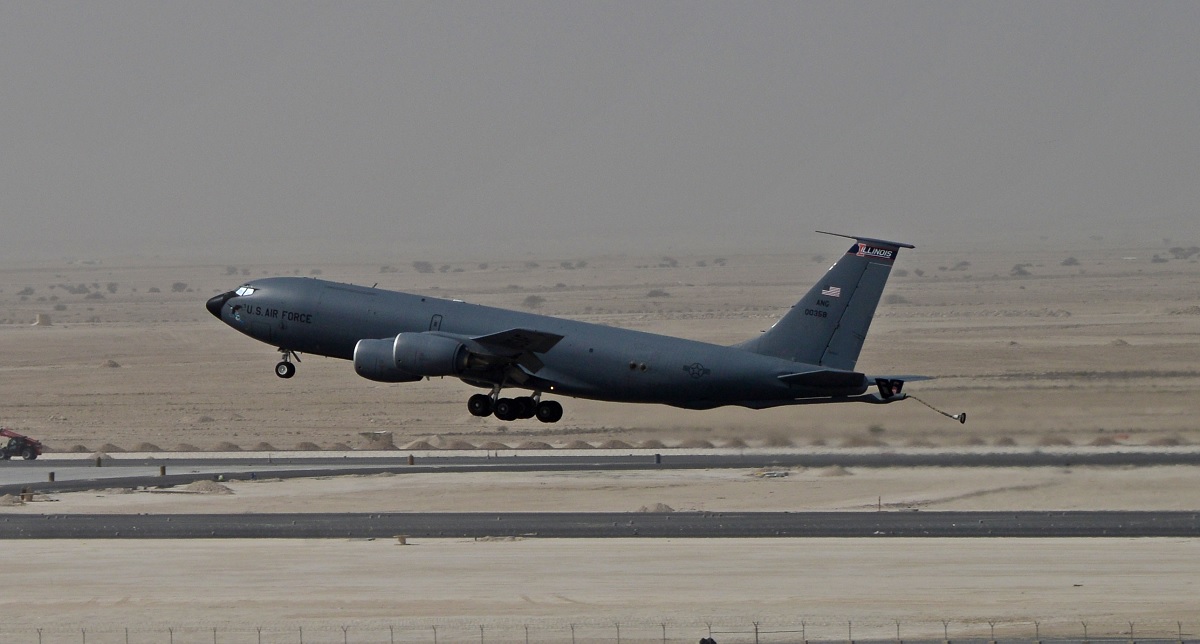“The KC-135 was the linchpin of the fight, without fuel, fighters are inoperable”
KC-135 Stratotankers responded to a new demand for assistance in 1990 during Operation Desert Shield, which started a 25-year period of continuous U.S. Air Force (USAF) contingencies.
The tankers needed to be maintained ready to go at a moment’s notice even if combat activities hadn’t started in earnest yet.
The preparation for the upcoming conflict was advancing. As the battle was set to start, things began to pick up about the middle of January. Operation Desert Storm started on January 17, 1991, just after midnight.
“Scud launches would create a flurry of activity, which would require KC-135 support,” said Lt. Col. Larry Dillon at the time KC-135 crewmember with 190th Air Refueling Wing (ARW). “Sometimes they would need 60 or more sorties before sunrise, and the next day the surge would occur in the late afternoon or evening. As a result, our aircrews had no schedule to live by. One day they would sleep days and fly nights, the next day vice versa.”
It would be like this for the next 38 days. It was a terrific pace to keep up.
During the conflict, the KC-135 crew known as “Balls 13” consisted of Lieutenant Col. Kevin Sweeney (pilot), Capt. Jay Selanders (co-pilot), Capt. Greg Mermis (navigator), and Senior Master Sgt. Steve Stucky (boom operator). After takeoff, they came upon jet spray (the turbulence behind a large aircraft). The tanker was suddenly pitched to one side, which caused both of its left-side engines to be torn off and provided very major control issues for the fully laden tanker. The truth is that nobody had ever run with this issue outside of a simulator.
Since there had never been a successful bailout from a KC-135, it required amazing skills and teamwork from the crew, and quite possibly their lives were on the line.

The pilots were under extreme pressure just trying to keep the tanker under control; in order to get it to take off, they had to manually move the tanker around. It was necessary to empty the fuel, map a course back to base, and, most importantly, lower the gear. Sgt. Stucky had to manually pump the gear down to do this. And after accomplishing that, the large tanker landed safely. For their actions that day, the crew members would each receive a Distinguished Flying Cross (DFC).
The KC-135s were initially deployed to ferry material, according to Stephen Yavornitzki, a former boom operator during the fight. However, the task soon required hours of aerial refueling support as well.
“The KC-135 was the linchpin of the fight,” said Yavornitzki. “Without fuel, fighters are inoperable.”
Refueling in the air for the boom operator and the rest of his team’s operations usually lasted three hours, during which the aircrew worked to maintain the airworthiness of aircraft like the F-16 Fighting Falcon and F-111 Aardvark.
“We [refueled] them both pre and post-fight,” he said. “Once they would go and drop their ordinance, they would come back up, get their fuel and head back out to the fight.”
Key enemy radars, command centers, air defenses, and different airfields throughout the area were all successfully destroyed by USAF planes.
The KC-135s were busy keeping other aircraft in the air and enabling them to finish the mission, even if these operations were not directly caused by the tankers.
“The KC-135 was the workhorse, the backbone, of the fight,” said Yavornitzki.
Over the duration of the mission, tankers flew more than 4,900 sorties in 19,700 flight hours, according to Air Mobility Command (AMC). To 14,588 receivers, their crews offloaded more than 28.2 million gallons of fuel.

Source: 60 YEARS IN THE AIR: KC-135 supports Gulf War contingencies by Senior Airman Tara Fadenrecht, 22nd Air Refueling Wing Public Affairs, and U.S. Air Force; Photo by Tech. Sgt. Jason Robertson and Senior Airman Kia Atkins / U.S. Air Force; Tech. Sgt. Perry Heimer / Department of Defense

